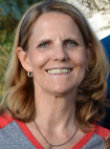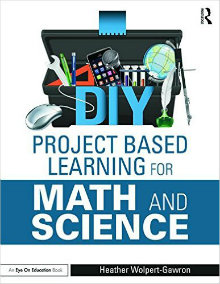A Superior Guide to Project Based Learning
DIY: Project Based Learning for Math and Science
By Heather Wolpert-Gawron
(Routledge/Eye on Education, 2016 – Learn more)
 Reviewed by Sandy Wisneski
Reviewed by Sandy Wisneski
If you ask a selection of teachers what Project Based Learning involves, you’re likely to get many different answers. In the latest book in her DIY series, author and middle school teacher Heather Wolpert-Gawron writes a simple definition:
PBL is the act of learning through identifying a real-world problem and developing its solution. Kids show what they learn as they journey through the unit, not just at the end.”
 I especially applaud the idea of learning “as they journey” because isn’t that what education is about…the process? I realize that assessments need to take place and there are curriculum and standards to cover, but if the only reason to learn is to take an assessment, then something is missing.
I especially applaud the idea of learning “as they journey” because isn’t that what education is about…the process? I realize that assessments need to take place and there are curriculum and standards to cover, but if the only reason to learn is to take an assessment, then something is missing.
I teach in a PBL school. I started down this path after teaching in a traditional setting for 36 years. Learning what PBL means and how to incorporate it into the classroom takes time and training, but Wolpert-Gawron has prepared an extensive toolkit that will gently guide teachers into the first steps.
PBL is often confused with “doing a project”
In the introduction, the author prepares a foundation for Project Based Learning. I understand the importance of spending time explaining the PBL process because it is often confused with “doing a project.”
Heather Wolpert-Gawron has explained beautifully what PBL entails. I would like to hand this paragraph to everyone who wants a deeper understanding because it sums up the essential elements of PBL so well.
PBL is the ongoing act of learning about different subjects simultaneously. This is achieved by guiding students to identify, through a real-world problem, local or global, developing its solution using evidence to support the claims, and offering the solution using a multimedia approach to presentation using skills based in a 21st century set of tools. Kids show what they learn as they journey through the unit, interact with its lessons, collaborate with each other, and assess themselves and each other.”
The introduction offers a theory behind PBL, the essential pieces, and ways to adapt it to the classroom. At the end of the introduction, the author’s process when planning is developed in detail, including the integration of standards and assessments. It is hard to believe this much information comprises only the opening chapter, but it is a critical place to spend time before using the other well-planned units and resources.
The rest of the book
DIY: Project Based Learning for Math and Science will benefit both seasoned educators and those just starting out in PBL. The book is divided into two sections. Part I contains five full units:
- Overviews and descriptions of a whole unit and the goals and objectives
- FAQs about the unit – subjects that are integrated, skills, etc.
- Step-by-step and day-to-day guides toward implementing the unit
- Student samples
- Targeted rubrics
- Homework hints
Part II is a collection of tools that can be used in any PBL lesson. All resources can be found in digital format online. Some examples include:
- Google Advanced Search
- Understanding Infographics Lesson
- Norms for Video Conferencing
- Oral Presentation Rubric
- How to Comment on a Blog
One particular unit that interested me was “The Theme Park Unit.” In our school, we do a similar project called “The Ride of Your Life” which incorporates engineering, math, reading, and language arts standards. The author incorporates the following elements into her project:
- Writing
- Experts in the classroom
- Oral presentation
- Role-play
- Student choice
- Problem solving
- Collaboration
- Real-world connections
Various elements in the theme park (“Lands”) grow from small-group research about different scientists and their contributions. Groups then combine together to become an entire theme park. When I read this new twist, it challenged my own thinking as well as how I could implement this into our project.
The step-by-step lessons begin with a checklist that helps “communicate the overarching goals” so parents and students understand the process. It may appear that the final product is the goal in Project Based Learning, but assessment happens continually.
How the lessons are structured
During the theme park project, the student role-plays a theme park designer who will design the coasters, landscape the grounds, create a budget, and pitch the kingdom to a board who will determine if it will be funded.
- Entry Event: A video game gets the students engaged and thinking about both roller coasters and the layout of theme parks. In this example, students play Roller Coaster Tycoon using a set of guiding questions.
- Historic Era Theme Park: Each of the lands will be based on a historic era that reflects a particular scientist and his/her contributions.
- Selecting a Scientist/Research: Students select a scientist to focus their research. The author includes templates for students to complete during note taking and annotating.
- Collaboration Constitution: Norms for collaboration create a successful environment. Personally, I find this is an important, positive approach to group work that has been a teaching tool in our projects.
- Bringing an Outside Expert into the Classroom: Experts add to the “real-world” experience.
Wolpert-Gawron continues with 23 more process steps. Every step is detailed with examples and resources. Content integration, standards, assessments, written work, and evaluation are clearly explained in each unit. Lessons are clearly laid out so that someone beginning in PBL would be able to implement it successfully, while those who have been using PBL would find excellent resources and ideas.
In all, there are five PBL lessons, and the other four are just as detailed:
- The Genius Unit: A Unit Based on Informational Reading and Scientific Lab Reports.
- The Invention Unit: A Unit Based on Inventing Solutions to Common Everyday Problems Using Persuasive Pitch Writing, Crowdsourcing, 3D Printing, and Digital Commercial Production.
- The Galapagos Unit: A Unit Committed to Funding a Mission to Save the Endangered and Unique Species of the Galapagos Islands.
- The Teach Them to Be Teachers Unit: A Unit Based on the Highest Level Of Communication of All.
Heather Wolpert-Gawron has written a resource that I wish had been available to read when I started on the PBL journey five years ago. Each unit is filled with innovative ideas and detailed steps to implement a PBL lesson.
And don’t let the title DIY: Project Based Learning for Math and Science limit you to only these content areas. The approach detailed in this book will energize any content classroom.
Sandy Wisneski is lead teacher at Catalyst Charter Middle School in Ripon WI. She is the district webmaster, a tech mentor and yearbook advisor, as well as IE mentor. Over the past 40 years Sandy obtained her masters in reading, became certified as a Flat Classroom Teacher, a Common Sense Certified Educator and a BrainPOP Certified Educator. She’s been to summer camp twice – the Honeywell Educators @ Space Academy (2014) and the Honeywell Green Boot Camp in San Diego (2016). She enjoys challenging students to “take ownership” for their learning and to be effective digital citizens in the world. Find Sandy @stampcat2, Stampcat2TechnifiedBlog, and CatalystChannelBlog.































